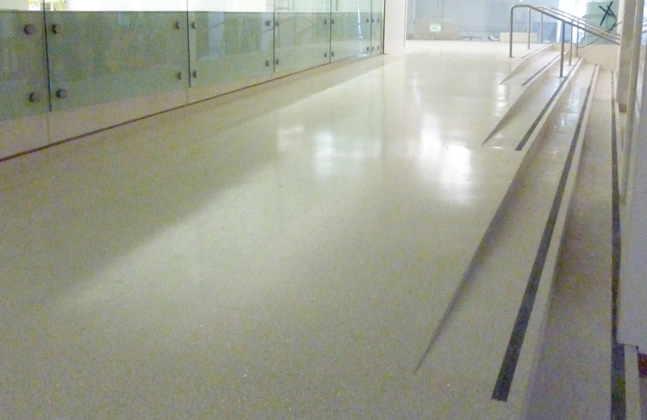Educational facilities need to create environments that engage and inspire, which means not just hiring great teachers and getting the best learning materials – but it also means making sure that the building surrounding the students actively encourages learning.
The floor is a key element in this, as choosing a bland finish runs the risk of instilling an “institutional” feel to the space, which is hardly conducive to effective engagement. Likewise specifying a floor that’s not up to the challenges of a school could result in a failed floor and no matter how colourful or decorative it is, if the floor is cracked, dirty, dusting or unsightly then it will also have a negative impact on the site’s educational goals.
Crucial School Flooring Properties
So ideally a school’s floor finish needs to combine several key properties, namely: attractive visuals, durability, safety and easy cleanability. Choosing a solution that meets these four demands will ensure that the surface underfoot facilitates an effective learning environment.
Resin systems have become a popular choice among school designers for their ability to deliver on each of these demands. This was exemplified recently at a South African day care centre that had to cope with a number of extreme challenges and where the floor really helped to make the facility a more pleasant space for the young children.
The Project Feed the Children Early Childhood Development Day Care Centre is located in an impoverished rural township on the outskirts of Benoni, Gauteng. It was founded to provide babysitting and educational services to approximately 85 children aged 18 months to six years, who attend the centre’s crèche on a daily basis.
However the centre’s founders recognised that its existing bare cement floor was not ideal, as it was dull, unprotected and not easy to clean – which was especially problematic with over 80 children walking in mud from outside every day. To help rectify this situation, Flowcrete South Africa donated 90 m2 of the vibrant, epoxy resin floor finish Peran SL Fruity in a variety of bold colours including Tangerine, Kiwi and Grapefruit.

The Project Feed the Children Early Childhood Development Day Care Centre needed a floor that would not only provide a colourful and happy environment but that would cope with the demands that only dozens of young children can exert on a floor (scratches and scrapes from toy diggers for example).
Zina Rotherham, Development and Project Manager at The 100% Foundation, which works with the day care centre, told us “the educators are inspired and excited about the floors. Working in this environment can be challenging, there is a lot of sand and mud and when the weather is bad the problems expand.
“With the new floors they will be able to keep the classroom cleaner…the children also nap on a mat during the day and this flooring is much more comfortable than the cement flooring and not as cold.”
The durability of resin systems like this is a distinct advantage in environments such as early learning centres, as it is able to withstand the inevitable scuffs, scrapes, scratches and spillages that it will be subjected to – maintaining its aesthetic and functional properties for the long term.
Optimising the Floor Area
The flexibility of resin systems allows for the creation of bespoke finishes as well as the inclusion of anti-slip aggregates and even antimicrobial additives!
The material’s design potential was embraced by Westminster University when it undertook a large-scale upgrade of its Marylebone campus. A highly decorative, joint free surface was required for the reception and main concourse areas, including a one-of-a-kind ramp with a combined stair detail. To create this floor area the project’s designers used the seamless resin terrazzo system Mondéco Crystal Ice.

Westminster University found seamless resin terrazzo to be a great way to create a decorative and robust floor.
The texture of resin flooring systems can even be tailored to match the slip resistance needs of specific parts of a school. This means that entrances and receptions where rainwater is likely to make its way inside can have enhanced anti-slip properties to reduce the chance of painful slips and trips.
For kitchen and catering areas the most important criteria is hygiene. The floor should be seamless, impervious and easy to clean and what’s more it needs to maintain these properties for the long term despite thermal shock from hot ovens, heavy equipment and spillages of corrosive foodstuffs. Robust polyurethane systems with an antimicrobial additive are advisable for these areas.

![Shot 4 EDIT [low Quality] Shot 4 EDIT [low Quality]](https://allthingsflooring.com/wp-content/uploads/2017/07/shot-4-EDIT-low-quality-647x420.jpg)
![FlowcreteCreche006 EDIT [low Quality] FlowcreteCreche006 EDIT [low Quality]](https://allthingsflooring.com/wp-content/uploads/2017/07/FlowcreteCreche006_EDIT-low-quality-647x420.jpg)
![Shot 31 EDIT [low Quality] Shot 31 EDIT [low Quality]](https://allthingsflooring.com/wp-content/uploads/2017/07/shot-31-EDIT-low-quality-647x420.jpg)
![FlowcreteCreche084 EDIT [low Quality] FlowcreteCreche084 EDIT [low Quality]](https://allthingsflooring.com/wp-content/uploads/2017/07/FlowcreteCreche084_EDIT-low-quality-647x420.jpg)
![2 Biblioteka Szynwald IMG 7593a EDIT [low Quality] 2 Biblioteka Szynwald IMG 7593a EDIT [low Quality]](https://allthingsflooring.com/wp-content/uploads/2017/07/2-biblioteka-szynwald-IMG_7593a-EDIT-low-quality-647x420.jpg)
![FlowcreteCreche009 EDIT [low Quality] FlowcreteCreche009 EDIT [low Quality]](https://allthingsflooring.com/wp-content/uploads/2017/07/FlowcreteCreche009_EDIT-low-quality-647x420.jpg)



